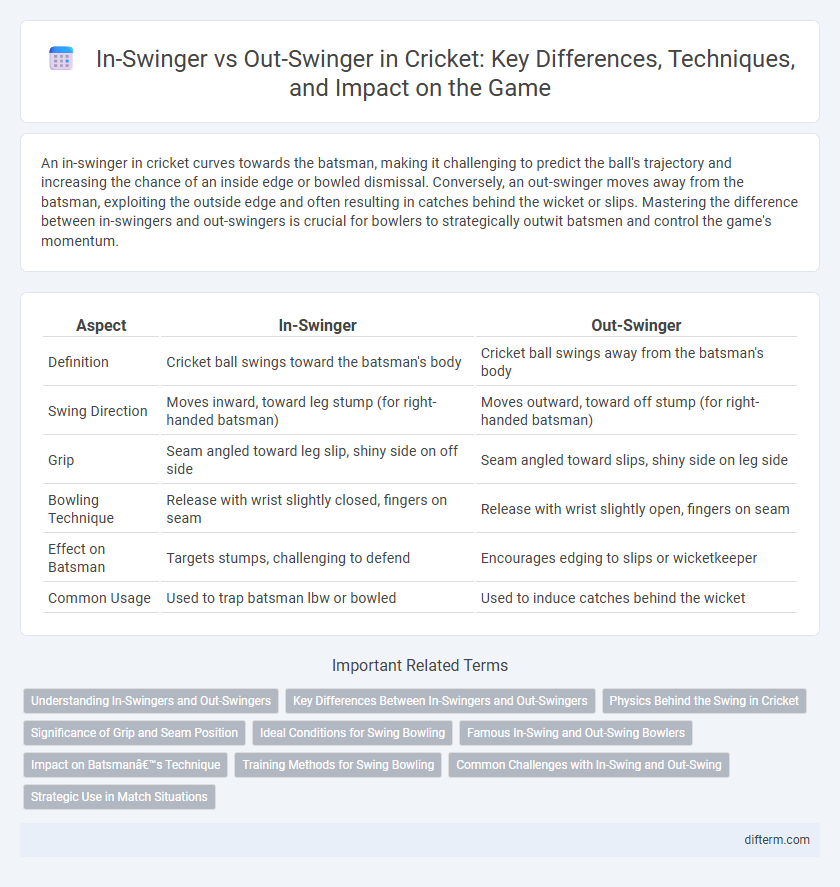An in-swinger in cricket curves towards the batsman, making it challenging to predict the ball's trajectory and increasing the chance of an inside edge or bowled dismissal. Conversely, an out-swinger moves away from the batsman, exploiting the outside edge and often resulting in catches behind the wicket or slips. Mastering the difference between in-swingers and out-swingers is crucial for bowlers to strategically outwit batsmen and control the game's momentum.
Table of Comparison
| Aspect | In-Swinger | Out-Swinger |
|---|---|---|
| Definition | Cricket ball swings toward the batsman's body | Cricket ball swings away from the batsman's body |
| Swing Direction | Moves inward, toward leg stump (for right-handed batsman) | Moves outward, toward off stump (for right-handed batsman) |
| Grip | Seam angled toward leg slip, shiny side on off side | Seam angled toward slips, shiny side on leg side |
| Bowling Technique | Release with wrist slightly closed, fingers on seam | Release with wrist slightly open, fingers on seam |
| Effect on Batsman | Targets stumps, challenging to defend | Encourages edging to slips or wicketkeeper |
| Common Usage | Used to trap batsman lbw or bowled | Used to induce catches behind the wicket |
Understanding In-Swingers and Out-Swingers
In cricket, understanding the mechanics of in-swingers and out-swingers is crucial for both bowlers and batsmen. An in-swinger moves towards the batter's body, typically delivered by bowlers who maintain the seam angled towards leg stump with an angled wrist, exploiting air pressure differences on the ball. Conversely, an out-swinger curves away from the batter, achieved by positioning the seam towards the slip fielders and using the shiny side of the ball to manipulate airflow and generate swing away from the batsman's body.
Key Differences Between In-Swingers and Out-Swingers
In cricket, the key differences between in-swingers and out-swingers lie in the direction of ball movement after release; an in-swinger curves towards the batter's body, while an out-swinger moves away towards the off side. The grip and seam position are crucial, with the seam angled towards slips for out-swingers and towards leg slip for in-swingers, influencing the air pressure around the ball. Swing bowlers use these variations to deceive batsmen by manipulating the ball's swing trajectory through atmospheric conditions and bowling techniques.
Physics Behind the Swing in Cricket
In cricket, the physics behind the in-swinger and out-swinger involves manipulating the ball's aerodynamics through seam position and airflow. For an in-swinger, the seam is angled toward the leg side, causing turbulent airflow on one side and smooth airflow on the other, resulting in the ball swinging inward toward the batsman. Conversely, an out-swinger has the seam angled away from the batsman, creating a pressure difference that makes the ball swing outward, exploiting the Magnus effect and differential air pressure for lateral deviation.
Significance of Grip and Seam Position
The significance of grip and seam position in cricket's in-swinger versus out-swinger largely determines the ball's deviation trajectory and effectiveness. A slightly angled seam and precise finger placement influence the air flow, causing the ball to swing either into or away from the batsman. Mastery of these elements allows bowlers to strategically manipulate swing, enhancing wicket-taking potential and control during fast bowling spells.
Ideal Conditions for Swing Bowling
Ideal conditions for swing bowling in cricket include humid weather and overcast skies, which help maintain ball moisture and enhance aerodynamic movement. A slightly worn cricket ball with a rough, shiny side facilitates differential airflow, enabling bowlers to generate both in-swing and out-swing effectively. Seam position and bowling pace further influence the degree of swing, with medium-fast bowlers often exploiting these factors for maximum deviation.
Famous In-Swing and Out-Swing Bowlers
Famous in-swing bowlers like James Anderson and Glenn McGrath have mastered the art of curving the cricket ball into the batsman, using wrist position and seam orientation to generate late movement. In contrast, out-swing bowlers such as Wasim Akram and Simon Jones excel by angling the ball away from the batsman, creating challenges through strategic seam position and wrist control. These legendary bowlers demonstrate precision and skill in manipulating swing, making the in-swinger and out-swinger potent weapons in cricket's fast bowling arsenal.
Impact on Batsman’s Technique
In-swingers challenge the batsman by moving the ball towards the leg stump, requiring a precise adjustment in footwork to maintain balance and play with the swing effectively. Out-swingers pose a threat by moving away from the batsman's body, demanding a more cautious and technically sound outside edge defense to avoid catches or bowled dismissals. Mastery over handling both deliveries significantly improves a batsman's adaptability and scoring ability under varying bowling conditions.
Training Methods for Swing Bowling
Training methods for swing bowling emphasize seam position control, wrist alignment, and consistent release to master both in-swingers and out-swingers. Drills using ball-targeting cones and video analysis enhance precision in swing direction and movement. Strengthening forearm muscles and improving grip flexibility contribute significantly to executing effective swing variations.
Common Challenges with In-Swing and Out-Swing
In cricket, bowlers often face challenges with controlling the in-swinger and out-swinger due to the precise wrist position and seam orientation required to generate movement. Variability in weather conditions and ball wear significantly affects swing potential, making consistent delivery difficult to achieve. Batsmen also find it challenging to anticipate swing direction, increasing the likelihood of edges and dismissals.
Strategic Use in Match Situations
In cricket, the strategic use of in-swingers and out-swingers significantly influences match outcomes by targeting the batsman's weaknesses and pitch conditions. Bowlers employ in-swingers to lure the batsman into playing inside the line, increasing the chances of leg before wicket (LBW) or bowled dismissals, while out-swingers are used to entice outside-edge errors for catches in the slips or wicketkeeper. Captains often strategize the deployment of both deliveries in sequences to maintain pressure and disrupt the batsman's rhythm, especially during Powerplays and death overs.
in-swinger vs out-swinger (cricket) Infographic

 difterm.com
difterm.com